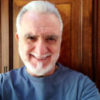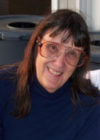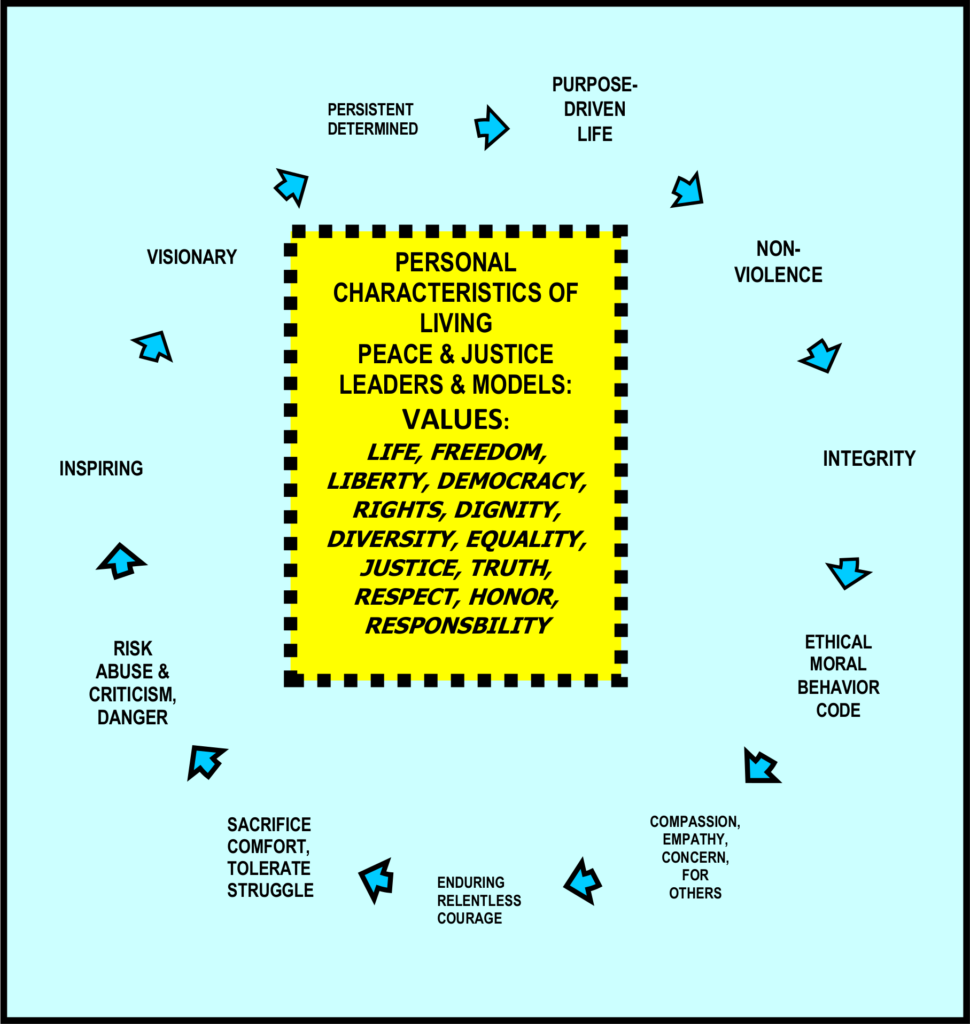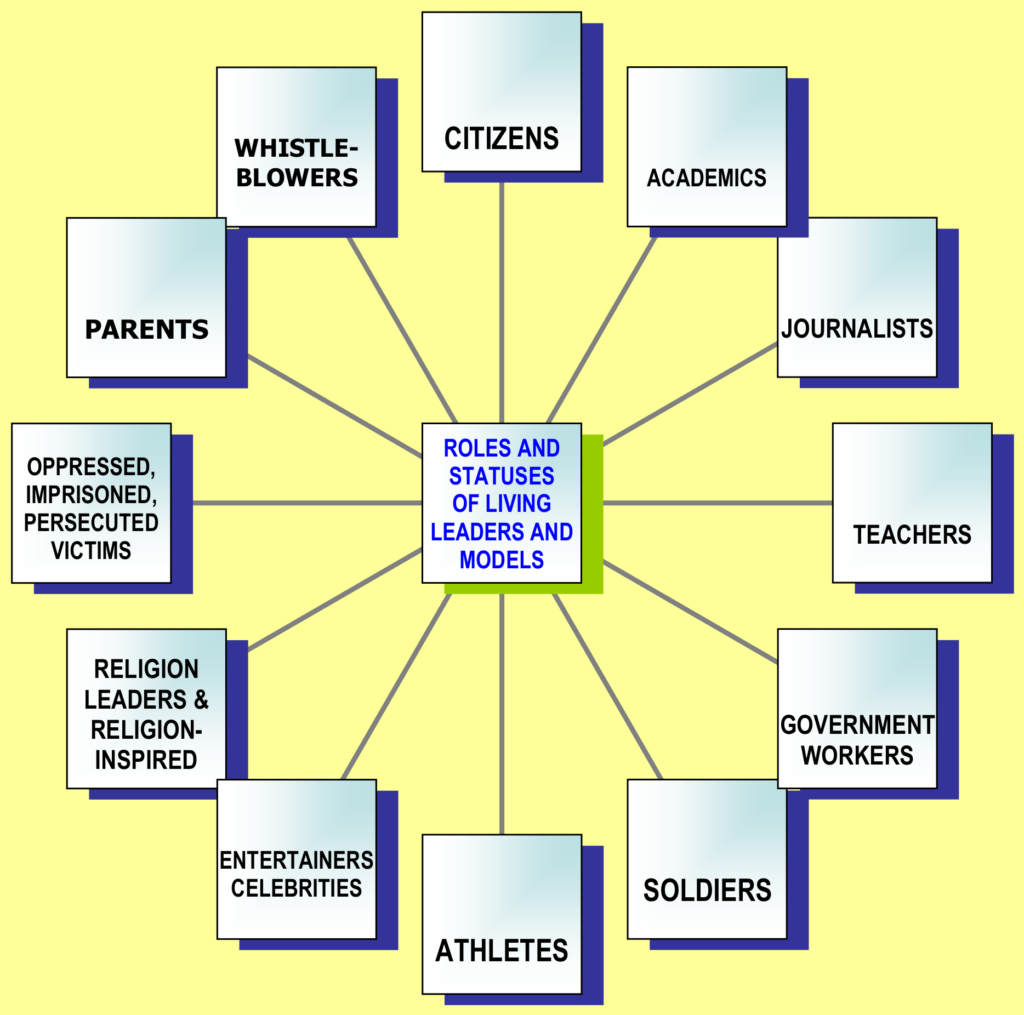In Pursuit of Peace and Justice: 100 Peace & Justice Leaders and Models (List #2)
TRANSCEND MEMBERS, 19 Feb 2018
Anthony J. Marsella, Ph.D., & Kathie Malley-Morrison, Ed.D. – TRANSCEND Media Service
14 Feb 2018 – Be not afraid! You are not alone! There are thousands of advocates and activists across the world bringing conscience to the struggle for peace and justice. It is the endless story of individuals from all walks of life, willing to endure the trials and tribulations of speaking for and defending peace and justice in settings in amidst abuses and oppression as human rights and legal rights are denied, violated, or punished by those in power and position.
In the omnipresent face of abuses and oppression, we recall iconic peace and justice leaders of the past, including Mahatma Gandhi, Martin Luther King, Jr., Nelson Mandela, Samuel Gompers, Caesar Chavez, Larry Itliong, Rachel Corrie, Philip Berrigan & Daniel Berrigan, Glenn Paige, Hedy Epstein, Malcolm X, and so many others. Peace and justice advocates and activists, across time, are testimony to the enduring human spirit to resist oppression to claim liberty, and to endure, even when the costs are life.
This is the second list of living peace and justice advocates and activists we have compiled and published (see: Marsella, A.J., & Malley-Morrison, K. [January 29, 2018, In Pursuit of Peace and Justice: 100 Peace and Justice Leaders and Models, Transcend Media Service). Our efforts are continuous with intentions to celebrate Reverend Martin Luther King, Jr.’s enduring contributions to peace and justice, beyond his designated annual memorial holiday on January 15, 2018.
We are eternally grateful for Reverend King’s efforts to free people and nations from the brutal oppressions imposed by governments, nations, societies, organizations, and individuals. Regardless of source, those who willfully support and sustain the evils of racism, prejudice, violence, and war, will yield to peace and justice leaders.
Reverend King’s commitment to freedom from oppression and abuse compel us to continue his efforts far beyond the words, song, and promises of his day. His abuse from corrupt government offices and officials likely resulted in his assassination. Reverend King’s awareness of his persecution did not prevent him from continuing his efforts, for he knew even in his death, his truths would endure.
To this end, we, (i.e., Kathie Malley-Morrison & Anthony J. Marsella), the authors of this effort, have chosen to demonstrate our responsibilities and commitment to Reverend King truths by identifying 100 living peace and justice leaders and models. This is the second list. The first list was very well received, and now stands as a resource for peace and justice efforts across the globe.
Our choice of the number 100 is arbitrary, for there are thousands of individuals who deserve citation. Most are not listed; we will continue to create list for future efforts. Do not be dismayed! Patience! We believed it essential to develop lists of living peace and justice activists and advocates to encourage and foster peace and justice work.
The individuals included on our current list are from all genders, ages, roles. They are from many nations, ethnocultural groups, and “races.” There is a rising tide of commitment to peace and justice; there is an intolerance of the corruption, cronyism, and asymmetric power, sustaining current abuses. There is a new spirit of resistance to the old-world moral order, dominated too long by a limited number of oligarchs and martial nations.
Almost two decades ago, David Reiff (1999), in his classic paper, “The precarious triumph of human rights” (New York Times Magazine, August 8, pp. 36-4) articulated his view of “new moral order” characteristics; his thoughts were prescient:
- Civil society;
- Humanitarianism;
- Human rights versus state sovereignty;
- Emergence of human rights activists, development workers, aid experts committed to needs of an interdependent world;
- Small is beautiful;
- Democracy building;
- Growth of NGOs;
- Considering individual as well as state rights;
- Plans for a permanent international criminal court.
To these, we would add the following: decentralization, grass-roots participation, non-violence, communication/networking, and a determination to question and to hold accountable those with wealth, power, and position fail to act in responsible societal ways.
There are other characteristics which could be added as the world begins to respond to the abuses of those individuals, societies, and nations that have insidiously acquired dominance and position.
There is a new spirit of encounter (e.g., Black Lives Matter); a new spirit of protest evidenced by DC gatherings for women and minority groups; a new spirit of communication among media free of government or wealth controls; there is a new spirit of protest against war and militarism, and the spending of a nation’s wealth on weaponry and endless war; there is a new spirit of concern for life and land, especially regarding anthropogenic climate changes; there is a new spirit of determination to expose the abuses of privilege and position by select government official who have politicized and weaponized laws for personal use (e.g., FISA).
These emerging changes signal and sustain “Hope!” “Hope” is the life blood of progressive change. “Hope” can be suppressed and oppressed, but it cannot be defeated. “Hope” endures because it is the essence of life. Regardless of life forms and species, “Hope” is the evolutionary impulse pursuing survival and becoming.
We consider our efforts a beginning, and we will continue to publish new lists. This is so because the struggle for peace and justice is endless, and each day new people are rising to the call. This is as it should be, and must be, until such time as the forces of oppression fall before the forces of good; evil will continue, but human virtue, endowed in human conscience, will triumph!
The work of many of those included in this list will be nationally recognized; some have made their contributions locally or in specialized areas. We have attached website information to each name to offer insight into their efforts. Please access the name and URL to learn more about each of these remarkable individuals. The message from each of these individuals is clear: “Do what you, how you can, and when you can to promote peace and justice.”
There is something very “special” about the individuals appearing on the lists of peace and justice advocates and activists: it is the recognition that peace and justice activism advocacy are not simply occasional actions. Rather, they are a way of life; the calling is present in temperament and being. Gelb’s (1999) listing of principles of Leonardo DaVinci, in his volume “How to think like Leonardo DaVinci,” captures the characteristics of the individuals on this list of peace and justice leaders. These principles are noted in Table 1: While not every quality is present in every individual, it is clear from their peace and justice efforts, many of the qualities are present.
What the individuals on this list of 100 peace and justice leaders add to Leonardo DaVinci’s principles is enduring concern for the human condition, and especially the suffering of others. It is the ever-increasing levels of advocacy and activism, proceeding form concern to accompany. This is the the essential requirement of humanism: Concern, Sympathy, Empathy, Compassion, Accompany.
Table 1
Seven Principles of Leonardo DaVinci
M.J. Gelb (1999) How to think like Leonardo da Vinci. NY: DTP
- Curiosita: An insatiable curious approach to life and an unrelenting quest for continuous learning;
- Dimostrazione: A commitment to test knowledge through experience, persistence, and a willingness to learn from mistakes;
- 3. Sensazione: The continual refinement of the senses, especially sight as a means to enliven experience;
- 4. Sfumato: A willingness to embrace ambiguity, paradox, and uncertainty; (“To go up in smoke”);
- Arte/Scienza: The development of the balance between science and art, logic and imagination. (Whole brain thinking);
- Corporalita: The cultivation of grace, fitness, and poise;
- 7. Connessione: A recognition and appreciation of the interconnectedness of all things and phenomena. Systems thinking!
Before sharing our list, we wish to include two charts rendering graphic displays of essential material for understanding and appreciating living leaders.
CHART 1:
PERSONAL CHARACTERISTICS OF PEACE AND JUSTICE LEADERS AND MODELS
CHART 2: ROLES AND STATUSES OF LIVING PEACE & JUSTICE LEADERS AND MODELS
LIST OF 100 LIVING PEACE AND JUSTICE ADVOCATES, ACTIVISTS, AND MODELS:
- Abu-Nimr: Mohammad Abu-Nimr
- Adams: Glenn Adams
- Arbuthnot: Felicity Arbuthnot
- Arrigo: Jean Marie Arrigo
- Arredondo: Patricia Arredondo
- Awad: Murbarak Awad
- Baez: Joan Baez
- Barber: Reverend William Barber
- Barnat: Ilyad Barnat
- Bassett: Larry Bassett
- Belle: Deborah Belle
- Bigombe: Betty Oyella Bigombe
- Blackmon-Lowery: Lynda Blackmon-Lowery
- Blume: Art Blume
- Bowen: Kevin Bowen
- Bretherton: Diane Bretherton
- Bryant: Brandon Bryant
- Burghardt: Tom Burghardt
- Cacciatori: Joanne Cacciatori
- Campos: Pam Campos
- Caputi: Ross Caputi
- Carruthers: Charlene Carruthers
- Chappell: Paul Chappell
- Chomsky: Avi Chomsky
- Chossudovsky: Michael Chossudovsky
- Christie: Daniel Christie
- Clark: Ramsey Clark
- Connolly: David Connelly
- Cox: Lynell Cox
- D’Andrea: Michael D’Andrea
- Dunbar: Edward Dunbar
- Correia: Antone De’Jaun Correia
- Degirmencioglu: Serdar Degirmencioglu
- Drake: Thomas A. Drake
- Fihn: Beatrice Fihn
- Finklestein: Norman Finklestein
- Flowers: Margaret Flowers
- Fox: Matthew Fox
- Furtado: Michael Furtado
- Gagnon: Bruce K. Gagnon
- Giffords: Gabrielle Giffords
- Gillotti, Michael Gillotti
- Goldberg: Whoopi Goldberg
- Green: Paula Green
- Hall: Mitchell K. Hall
- Handwerker: Steven E. Handwerker
- Haney: Craig Haney
- Hazare: Anna Hazare
- Hines: Denise Hines
- Jackson-Lowman: Huberta Jackson-Lowman
- Kame’eleihiwa: Lilikalā K. Kame’eleihiwa
- Katz: Nancie L. Katz
- Kaye: Jeff Kaye
- Kelman: Herb & Rose Kelman
- Khan-Cullors: Patrisse Khan-Cullors
- Kimmel, Paul Kimmel
- Kivel, Paul Kivel
- Kis-Lev, Jonathan Kis-Lev
- Lapham: Lewis Lapham
- LeBlanc: Andrea LeBlanc
- LoCicero: Alice LoCicero
- Lopez-Lopez: Wilson Lopez-Lopez
- Lutz: Catheryn Lutz
- Lykes: Brinton Lykes
- Lyubanski: Mikhail Lyubanski
- MacNair: Rachel MacNair
- Maleno: Helena Maleno
- Martin: Abby Martin
- McKee: Ann McKee
- McKinney: Cynthia McKinney
- McKone: Anita McKone
- Moghaddam: Fathali Moghaddam
- Montiel: Christina Montiel
- Moore: Michael Moore
- Nelson: Linden Nelson
- Norsworthy: Kathryn Norsworthy
- Palast: Greg Palast
- Parenti: Michael Parenti
- Perlman: Diane Perlman
- Randa: Lewis Randa
- Rappoport: Jon Rappoport
- Robinson: Rashad Robinson
- Rosenberg: Carol Rosenberg
- Secker: Glyn Secker
- Shetterly: Robert Shetterly
- Shiva: Vandana Shiva
- Sivaraksa: Sulak Sivaraksa
- Soldz: Stephen Soldz
- Solomon: Norman Solomon
- Spieler: Susan Spieler
- Stout: Christopher E. Stout
- Sveaass: Nora Sveaass
- Valent: Roberto Valent
- Wadlow: Rene Wadlow
- Wasfi: Dahlia Wasfi
- Wessells: Michael Wessells
- Wise: Steven M.Wise
- Wollman: Neil Wollman
- Wright: Ann Wright
- Zeese: Kevin Zeese
Join us in celebrating the individuals making our world a better place for all — individuals advancing the human and natural order.
________________________________________________
 Anthony J. Marsella, Ph.D., a member of the TRANSCEND Network for Peace Development Environment, is a past president of Psychologists for Social Responsibility, Emeritus Professor of psychology at the University of Hawaii’s Manoa Campus in Honolulu, Hawaii, and past director of the World Health Organization Psychiatric Research Center in Honolulu. He is known internationally as a pioneer figure in the study of culture and psychopathology who challenged the ethnocentrism and racial biases of many assumptions, theories, and practices in psychology and psychiatry. In more recent years, he has been writing and lecturing on peace and social justice. He has published 21 books and more than 300 articles, tech reports, and popular commentaries. His TMS articles may be accessed HERE and he can be reached at marsella@hawaii.edu.
Anthony J. Marsella, Ph.D., a member of the TRANSCEND Network for Peace Development Environment, is a past president of Psychologists for Social Responsibility, Emeritus Professor of psychology at the University of Hawaii’s Manoa Campus in Honolulu, Hawaii, and past director of the World Health Organization Psychiatric Research Center in Honolulu. He is known internationally as a pioneer figure in the study of culture and psychopathology who challenged the ethnocentrism and racial biases of many assumptions, theories, and practices in psychology and psychiatry. In more recent years, he has been writing and lecturing on peace and social justice. He has published 21 books and more than 300 articles, tech reports, and popular commentaries. His TMS articles may be accessed HERE and he can be reached at marsella@hawaii.edu.
 Kathleen Malley-Morrison, Ed.D., Director of the Group on International Perspectives on Governmental Aggression and Peace (GIPGAP), is Professor Emerita of Psychological and Brain Sciences at Boston University. She is the author or coauthor of several books, including Family Violence in a Cultural Perspective, and Family Violence in the United States, as well as editor of the four volume series: State violence and the right to peace: An international survey of the views of ordinary people. She has authored numerous articles and book chapters on violence within relationships and nations. Her current efforts to advance peace and social justice are centered primarily in her blog, Engaging Peace. http://engagingpeace.com. She can be reached at: kathiemm@engagingpeace.com
Kathleen Malley-Morrison, Ed.D., Director of the Group on International Perspectives on Governmental Aggression and Peace (GIPGAP), is Professor Emerita of Psychological and Brain Sciences at Boston University. She is the author or coauthor of several books, including Family Violence in a Cultural Perspective, and Family Violence in the United States, as well as editor of the four volume series: State violence and the right to peace: An international survey of the views of ordinary people. She has authored numerous articles and book chapters on violence within relationships and nations. Her current efforts to advance peace and social justice are centered primarily in her blog, Engaging Peace. http://engagingpeace.com. She can be reached at: kathiemm@engagingpeace.com
This article originally appeared on Transcend Media Service (TMS) on 19 Feb 2018.
Anticopyright: Editorials and articles originated on TMS may be freely reprinted, disseminated, translated and used as background material, provided an acknowledgement and link to the source, TMS: In Pursuit of Peace and Justice: 100 Peace & Justice Leaders and Models (List #2), is included. Thank you.
If you enjoyed this article, please donate to TMS to join the growing list of TMS Supporters.

This work is licensed under a CC BY-NC 4.0 License.


An excellent list! Thanks for the work.
Two suggestions:
1. Please correct the spelling mistake in your naming of Mahatma Gandhi. It is MAHATMA GANDHI (meaning, Gandhi, the Great Soul), and Not MOHATMA….
2. Pope Francis is, in my opinion, a name that must be there on the list. Surprised to see it missing.
Best,
~ Paulson
[…] is a somewhat condensed version of a post that appeared today on Transcend Media Services. Part 2 will appear 2/19/2018 on this […]
It’s a pretty good list, and thanks for compiling it. Of course, it’s very incomplete.
The introductory material is also quite good–from da Vinci to the authors of this compilation.
As the authors note: “Our choice of the number 100 is arbitrary, for there are thousands of individuals who deserve citation. Most are not listed; we will continue to create list for future efforts.”
I look forward to reading those future lists, and learning more about the individuals cited.
One glaring omission on this first list is that of Johan Galtung, the pioneer of “Peace Studies” as an academic discipline, a major contributor to peace movements, peace-journalism, peace-writing for over 50 years. (And, not incidentally, the guiding hand of the TMS site.)
Much thanks!
The list of peacebuilders is so much larger than this.
Off the top of my head I can name Michael Nagler, David Swanson, Dot Maver, Pope Francis, Ban ki Moon, Leo DiCaprio, and so many others – thousands of people toiling for justice across the planet. We are raising ourselves above the radar.
We need to put everyone on this map to help transcend the chaos that is before us.
Thank you for the conversation.
Most of the alleged missing names are on the first list. Link at the beginning of article.
A lot af brave, impressive, highly intelligent and worthy names!
BUT… more than 75% of the persons here are American. Where are the Russians? Where are the Chinese? Where are the African peace leaders?
Africa is home to 16% of the worlds population. China close to 20%.
Agree with Jon Steffansson’s comment above about adding non-Americans to the list. Perhaps Jon will make worthy suggestions….
Some other Americans to consider for the next list: Gareth Porter (journalist & author; winner of the international Garry Webb Award); Carolyn Baker (author; healer; numerous books); Wendell Berry (now 83, one of the US’s best contemporary poets); Rianne Eisler (author of the internationally-acclaimed, “The Chalice and the Blade”); David Loye (author of “Darwin’s Lost Theory of Love”).
Dear Gary
No, my problem is that if I was asked to name people after these criteria, I would find it difficult to find other names than the suggested here.
Which may be the problem in itself. An inward-looking group of (mainly) Americans looking (mainly) at America. Galtung is not American but (I think?) live there, and mostly write about America (the bad things).
But how to move from an American-centric “universe” (no pun..) to a global? I dunno…
[…] ‘In Pursuit of Peace and Justice: 100 Peace & Justice Leaders and Models (List #2)’. […]
[…] “En pos de la paz y la justicia: 100 líderes y modelos de paz y justicia (Lista #2)“. […]